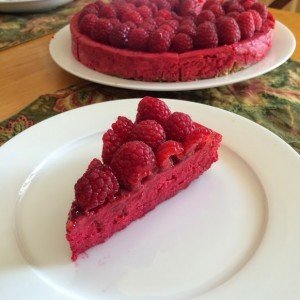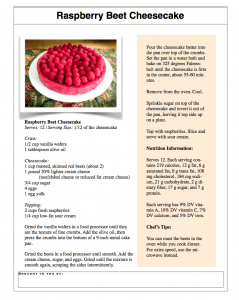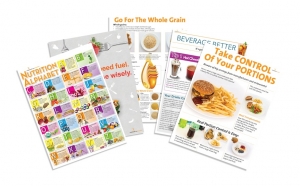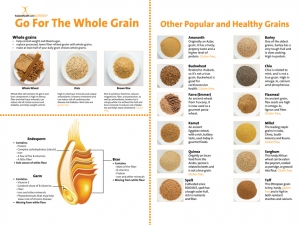Raspberry Beet Cheesecake
 Looking for a shockingly good dessert?Have I ever got the recipe for you!I could not be more excited about this incredible dessert, which I first developed for the Nutrition Month Communicating Food for Health newsletter last year. Ever since its debut, rave reviews have been pouring in. So I decided it was long past time to offer you a free handout with this recipe. After all, how better to help your clients bite into a healthy lifestyle?Anyway, here is the downloadable handout in all its glory. If you'd like a preview of the recipe, check out the text below...
Looking for a shockingly good dessert?Have I ever got the recipe for you!I could not be more excited about this incredible dessert, which I first developed for the Nutrition Month Communicating Food for Health newsletter last year. Ever since its debut, rave reviews have been pouring in. So I decided it was long past time to offer you a free handout with this recipe. After all, how better to help your clients bite into a healthy lifestyle?Anyway, here is the downloadable handout in all its glory. If you'd like a preview of the recipe, check out the text below... Raspberry Beet Cheesecake: Serves: 12, Serving Size: 1/12 of the cheesecakeCrust:
Raspberry Beet Cheesecake: Serves: 12, Serving Size: 1/12 of the cheesecakeCrust:
- 1/2 cup vanilla wafers
- 1 tablespoon olive oil
Cheesecake:
- 1 cup roasted, skinned red beets (about 2)
- 1 pound 30% lighter cream cheese (neufchâtel cheese or reduced fat cream cheese)
- 3/4 cup sugar
- 4 eggs
- 1 egg yolk
Topping:
- 2 cups fresh raspberries
- 1/4 cup low-fat sour cream
Directions:
- Grind the vanilla wafers in a food processor until they are the texture of fine crumbs. Add the olive oil, then press the crumbs into the bottom of a 9-inch metal cake pan.
- Grind the beets in a food processor until smooth. Add the cream cheese, sugar, and eggs. Grind until the mixture is smooth again, scraping the sides intermittently.
- Pour the cheesecake batter into the pan over top of the crumbs. Set the pan in a water bath and bake on 325 degrees Fahrenheit until the cheesecake is firm in the center, about 55-60 minutes.
- Remove from the oven and let cool.
- Sprinkle sugar on top of the cheesecake and invert it out of the pan, leaving it top side up on a plate.
- Top with raspberries. Slice and serve with sour cream.
Nutrition Information:Serves 12. Each serving contains 219 calories, 12 g fat, 6 g saturated fat, 0 g trans fat, 108 mg cholesterol, 184 mg sodium, 21 g carbohydrate, 2 g dietary fiber, 17 g sugar, and 7 g protein.Each serving has 9% DV vitamin A, 10% DV vitamin C, 7% DV calcium, and 5% DV iron.Chef’s Tips:You can roast the beets in the oven while you cook dinner. For extra speed, use the microwave instead.So what did you think? If you like this recipe, consider signing up for the Communicating Food for Health newsletter, with the latest and greatest nutrition education materials. And, as always, there are lots of other wonderful cooking resources in the Nutrition Education Store. Here are a few of the top sellers...
And, as always, there are lots of other wonderful cooking resources in the Nutrition Education Store. Here are a few of the top sellers...




